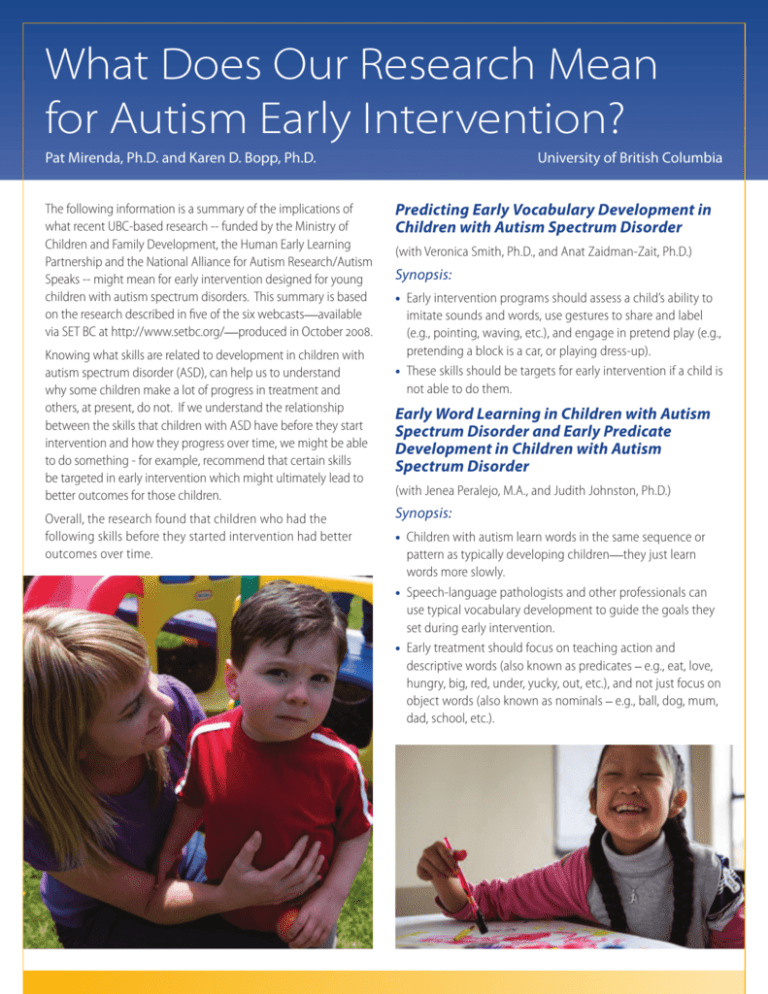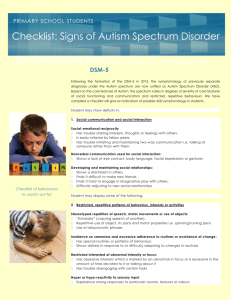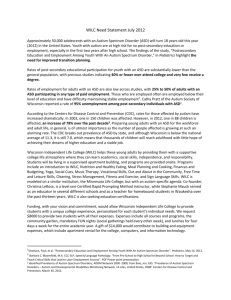What Does Our Research Mean for Autism Early Intervention?
advertisement

What Does Our Research Mean for Autism Early Intervention? Pat Mirenda, Ph.D. and Karen D. Bopp, Ph.D. The following information is a summary of the implications of what recent UBC-based research -- funded by the Ministry of Children and Family Development, the Human Early Learning Partnership and the National Alliance for Autism Research/Autism Speaks -- might mean for early intervention designed for young children with autism spectrum disorders. This summary is based on the research described in five of the six webcasts—available via SET BC at http://www.setbc.org/—produced in October 2008. Knowing what skills are related to development in children with autism spectrum disorder (ASD), can help us to understand why some children make a lot of progress in treatment and others, at present, do not. If we understand the relationship between the skills that children with ASD have before they start intervention and how they progress over time, we might be able to do something - for example, recommend that certain skills be targeted in early intervention which might ultimately lead to better outcomes for those children. Overall, the research found that children who had the following skills before they started intervention had better outcomes over time. University of British Columbia Predicting Early Vocabulary Development in Children with Autism Spectrum Disorder (with Veronica Smith, Ph.D., and Anat Zaidman-Zait, Ph.D.) Synopsis: •• Early intervention programs should assess a child’s ability to imitate sounds and words, use gestures to share and label (e.g., pointing, waving, etc.), and engage in pretend play (e.g., pretending a block is a car, or playing dress-up). •• These skills should be targets for early intervention if a child is not able to do them. Early Word Learning in Children with Autism Spectrum Disorder and Early Predicate Development in Children with Autism Spectrum Disorder (with Jenea Peralejo, M.A., and Judith Johnston, Ph.D.) Synopsis: •• Children with autism learn words in the same sequence or pattern as typically developing children—they just learn words more slowly. •• Speech-language pathologists and other professionals can use typical vocabulary development to guide the goals they set during early intervention. •• Early treatment should focus on teaching action and descriptive words (also known as predicates – e.g., eat, love, hungry, big, red, under, yucky, out, etc.), and not just focus on object words (also known as nominals – e.g., ball, dog, mum, dad, school, etc.). What Predicts General Language Development in Children with Autism? Are Problem Behaviors Related to Language Development in Children with ASD? Synopsis: Synopsis: •• The ability to engage in simple social or people games and other play routines and to point to objects and label them socially to another person are both important. •• These skills require children to be able to take turns, imitate actions and words, and point in order to label and share information. •• If young children with ASD do not have these skills, they should be included in early intervention programs. •• All of these skills occur during social play—not play with toys, but play with people—so lots of social play is important! •• The ability to pay attention to people and activities and to interact socially with other people are both important for young children with ASD in order for them to learn language. To teach children better attention skills, parents and professionals can: •• Use toys and activities that are motivating to the child. When something is motivating then a child is more likely to attend and they are also more likely to interact with another person. •• Structure or arrange the environment to gain the child’s attention by reducing the number of distractions in a room. For example, taking down colourful mobiles from the ceiling, facing the child towards the walls of the room instead of toward an open area. •• Be predictable and teach within familiar routines – Doing something over and over in a predictable way allows the child to focus on the language involved within the routine rather than worrying about what comes next. •• Use visual/picture supports – pictures do not disappear like spoken words and so the child has a longer time to take in the information. •• Use visual schedules – visual schedules allow a child to see what is happening next – when there will be a break etc. – this allows them to concentrate more on the task at hand. •• Provide choices to give the child a sense of control. •• Get down to the child’s eye level to help them focus. •• Use simple language with lots of expression to emphasize the key message. •• Teach or target attending skills directly within early intervention. To teach children to interact socially, parents and professionals can: •• Make sure that learning is fun! •• Provide activities that require social skills such as turntaking, imitation, and sharing another person’s attention to a favourite toy. •• Include person-to-person games and routines (e.g., tickle play, chase, songs with actions, peek-a-boo, horsey rides, etc.) October, 2008 © Pat Mirenda, Ph.D., and Karen Bopp, Ph.D.






